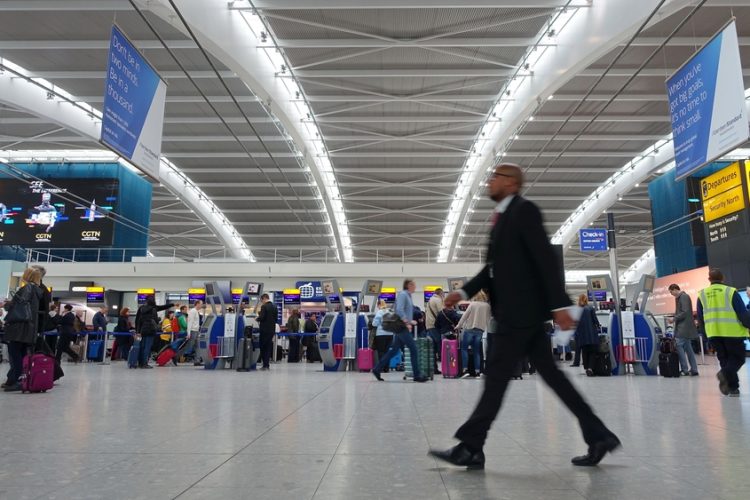European passenger traffic recovered by nearly 50% in February, reports ACI Europe
- Like
- Digg
- Del
- Tumblr
- VKontakte
- Buffer
- Love This
- Odnoklassniki
- Meneame
- Blogger
- Amazon
- Yahoo Mail
- Gmail
- AOL
- Newsvine
- HackerNews
- Evernote
- MySpace
- Mail.ru
- Viadeo
- Line
- Comments
- Yummly
- SMS
- Viber
- Telegram
- Subscribe
- Skype
- Facebook Messenger
- Kakao
- LiveJournal
- Yammer
- Edgar
- Fintel
- Mix
- Instapaper
- Copy Link
Posted: 5 April 2023 | International Airport Review | No comments yet
ACI Europe, in their air traffic report of 2023, found that passenger traffic had recovered by 48%. The growth is accredited to an influx of international travel, with a lesser impact made by domestic.


ACI Europe reported a rise of passenger volumes for February 2023, across EU air networks.
European airport trade body ACI EUROPE have released its air traffic report for February 2023. The results found that passenger traffic across European networks increased by 48% in February, compared to that of last year. The promising figures are accredited to a growth of international passenger traffic (at 58%), while domestic passenger traffic made a humble impact (at 22%).
When compared to pre-pandemic (February 2019) levels, passenger traffic in February 2023 stood at -12% – almost unchanged over the preceding month (-11% in January 2023). 40% of Europe’s airports had recovered or exceeded their pre-pandemic volumes.
Significant performance variations across national markets
With an increase of 53%, EU+ airports1 grew passenger traffic at the fastest pace in February compared to the same month last year. This reflects the fact that Omicron-related restrictions remained the tightest across this block. The highest increases came from airports in Cyprus, Malta (both at +92%) and Austria (+81%).
When compared to pre-pandemic (February 2019) levels, EU+ passenger traffic stood at -12% – but with significant divergences in performance:
- 10 national markets achieved or exceeded a full recovery in February. The best performances came from airports in Portugal (+18.9%), Luxembourg (+10.9%), Cyprus (+9.7%), Malta (+5.3%) and Bulgaria (+4.9%)
- Conversely, airports in Slovakia (-46.7%), Slovenia (-38.5%) and Germany (-33%), the Czech Republic (-29.9%) and Sweden (-28.3%) remained the farthest from achieving a full recovery. This reflected a mix of factors including the impact of the war in Ukraine, the lack of penetration or loss of Low Cost Carrier traffic and industrial action
- Among the largest EU+ markets – and aside from the underperformance of airports in Germany – airports in Spain +2.2%) posted the best results followed by those in France (-7.3%), Italy (-10.6%) and the UK (-12.9%).
At airports in the rest of Europe2, passenger traffic grew by +23% in February compared to the same month last year.
The impact of the war weighed on performance – with the loss of all commercial air traffic for Ukrainian airports and passenger volumes increasing by just +1.5% at Russian airports. Meanwhile, other national markets posted impressive results, including airports in Israel (+111.2%), Armenia (+91.5%), Moldova (+89.7%) and Serbia (+88.2%).
When compared to pre-pandemic (February 2019) levels, passenger traffic in the rest of Europe became aligned with the EU+ market at -11%.
Airports in Uzbekistan (+116.6%), (+93.7%), Kosovo (+39.6%) and Serbia (+24.4%) far exceeded their pre-pandemic volumes. Those in the major market of Turkey (-6.8%) saw their performance affected by the devastating earthquakes that hit the country. Meanwhile, airports in Russia (+4.1%) remained above their pre-pandemic volumes as passenger traffic kept shifting to domestic and non-EU+ markets.
Recovery patterns shaping airport performance
Passenger traffic at the Majors (top five European airports in 20193) grew by +55% in February compared to the same month last year. Volumes remained -11.7% below pre-pandemic (February 2019) levels. The positive impact of the re-opening of the Chinese market was limited during the month – and still needs to materialise.
Amongst the current top five European airports4, Istanbul and Madrid remained the only ones having fully recovered their pre-pandemic (February 2019) levels:
- London-Heathrow went back to being the busiest European airport in February. Passenger traffic increased by +81.6% over the same month last year, allowing the British hub to reduce the gap with its pre-pandemic volumes (-5.1%)
- Istanbul came second, with passenger volumes growing by +41.6% over the same month last year and standing +4% above their pre-pandemic level. The Turkish hub was followed by Paris-CDG at +52.8% over February 2022 and -11.9% below its pre-pandemic volumes
- Madrid kept the fourth position with its passenger traffic at +45.1% over February 2022 and +0.6% above pre-pandemic levels. Amsterdam-Schiphol closed the league at +42.1% over February 2022 and -21.9% below its pre-pandemic volumes.
The passenger traffic performance of other large5 and capital airports in February reflected a recovery still largely driven by intra-European and transatlantic routes, fuelled by leisure demand and characterised by significant (but selective) capacity expansion from Ultra-Low Cost Carriers.
- Accordingly, Lisbon (+18.8%), Tel Aviv (+13.6%) Dublin (+2.4%), Athens (+2.2%) and Palma de Mallorca (+1.1%) all exceeded their pre-pandemic (February 2019) volumes
- Meanwhile, Berlin (-44.1%), Munich (-29.3%), Helsinki (-28.1%), Prague (-28.7%), Frankfurt (-25%) and London-Gatwick (-22.3%) and Stockholm (-21.5%) remained well below.
These same recovery patterns and market dynamics were to the continued benefit of a number of large Ultra-Low Cost airport bases, bringing their February 2023 passenger traffic well above their pre-pandemic (February 2019) levels: (+33.3%), Charleroi (+17.9%) and Bergamo (+17.6%).
They also benefitted regional and smaller airports6 serving popular tourist destinations and/or relying on Low Cost Carriers such as: Kutaisi (+59.2%), Varna (+58%), Funchal (+48.5%), Asturias (+42%), Memmingen (+36.4%), Rotterdam (+27.5%), Lodz (+34.2%), Paphos (+24.6%).
Freight and aircraft movements
Freight traffic across the European airport network decreased by -6% in February compared to the same month last year – but stood at +5% compared to their pre-pandemic (February 2019) level.
Frankfurt (-8% compared to February 2019) was the busiest European airport for freight traffic, followed by Leipzig (+20%), Amsterdam-Schiphol (-6%), London-Heathrow (-20%) and Istanbul (-1%).
Aircraft movements increased by +26% across the European airport network compared to the same month last year, with airports in the EU+ markets at +29% and those in the rest of Europe at +10%.
Data by airport groups
During the month of February, airports welcoming more than 25 million passengers per year (Group 1); airports welcoming between 10 and 25 million passengers (Group 2); airports welcoming between 5 and 10 million passengers (Group 3) and airports welcoming less than 5 million passengers per year (Group 4) reported an average adjustment of -12.7%, -8.8%, -8.7% and -6.7%, as compared to pre-pandemic traffic levels (February 2019).
The airports that reported the highest increases in passenger traffic for February 2023 when compared with February 2022 are as follows:
GROUP 1: Lisbon (+18.8%), Istanbul IST (+4%), Dublin (+2.4%), Athens (+2.2%) and Palma de Mallorca (+1.1%).
GROUP 2: Milan BGY (+17.6%), Porto (15.4%), Tel Aviv (+13.6%), Catania (+11.2%) and Tenerife Sur (+10.4%).
GROUP 3: Sochi (+68.3%), Belgrade (+25.5%), Charleroi (+17.9%), Lanzarote (+12.7%) and Fuerteventura (+10.5%).
GROUP 4: Biarritz (712.2%), Tirana (+93.7%), Varna (+58%), Funchal (+48.5%) and Asturias (+42%).
1 EU, EEA, Switzerland and UK.
2 Albania, Armenia, Belarus, Bosnia & Herzegovina, Georgia, Israel, Kazakhstan, Kosovo, Northern Macedonia, Moldova, Montenegro, Russia, Serbia, Turkey, Ukraine and Uzbekistan.
3 London-Heathrow, Istanbul, Paris-CDG, Amsterdam-Schiphol and Frankfurt.
4 London-Heathrow, Istanbul, Paris-CDG, Madrid and Amsterdam-Schiphol.
5 Airports with more than 25 million passengers per annum (2019).
6 Airports with less than 10 million passengers per annum (2019).
Related topics
Airport development, Airside operations, Economy, Passenger experience and seamless travel, Passenger volumes, Terminal operations, Tourism
Related airports
Adolfo Suárez Madrid-Barajas Airport, Amsterdam Airport Schiphol (AMS), Asturias Airport, Athens International Airport (ATH), Belgrade Nikola Tesla Airport (BEG), Berlin Brandenburg Airport (BER), Biarritz airport, Bromma Stockholm Airport (BMA), Brussels South Charleroi Airport (CRL), Catania Fontanarossa Airport (CTA), Dublin Airport (DUB), Frankfurt Airport (FRA), Fuerteventura airport, Funchal Airport, Helsinki Airport (HEL), Istanbul Airport (IST), Lanzarote Airport (ACE), Leipzig Halle Airport (LEJ), Lisbon Airport (LIS), London Gatwick Airport (LGW), London Heathrow Airport (LHR), Milan Bergamo Airport (BGY), Palma de Mallorca (PMI), Paris Charles de Gaulle Airport (CDG), Porto Alegre (POA), Sochi International Airport (AER), Tel Aviv’s Ben-Gurion Airport (TLV), Tenerife Sur Airport (TFS), Tirana airport, Varna (VAR)
Related organisations
Airports Council International (ACI Europe), Council of the EU
Related regions
Central and South Asia, Europe, Middle East, United Kingdom and Ireland


















